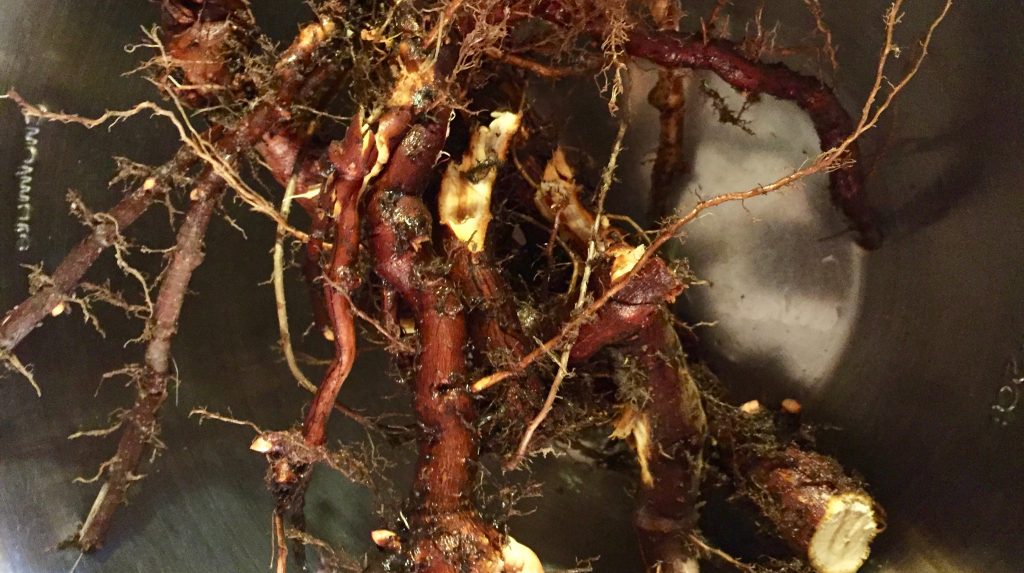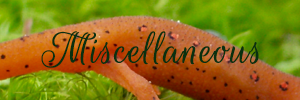Natural Insect and Tick Repellents
Here in New Hampshire – the one of the most Lyme-infested states in the nation – the joy and benefits of being outdoors are often marred by the uneasy fear of ticks. As rates rise across the country and the world, Lyme has become a controversial and challenging disease for our medical community. While it’s unlikely that we will completely eradicate the disease, herbs are showing promise in giving chronic Lyme patients their lives back.
According to the Centers for Disease Control, we have approximately 300,000 reported cases of Lyme in the country, though the organization admits that this number likely only represents 10 percent of actual cases. Quick action with antibiotic therapy after a bite often eliminates the Borrelia burgdorferi spirochete, the ancient and clever form of bacteria that causes Lyme disease. However, untreated or ineffectively treated Lyme may develop into chronic Lyme. Co-infections like Bartonella, Ehrlichia, and/or Mycoplasma transmitted by the tick are almost always present and may require separate therapies. This slippery slope of disease can be debilitating yet difficult to diagnose and treat. Although some people find near-miraculous relief from long-term antibiotic therapy, evidence suggests that its effects are not consistent, and the potential side effects can be severe. I personally know several people who have gone into liver failure from long-term Lyme-related antibiotics.
Core Herbs for Lyme & Coinfections
The lack of disease understanding and safe, reliable treatments have many chronic Lyme sufferers turning to herbs and natural therapies. We are still learning about these sophisticated and fast-adapting tick-borne disease organisms, but herbs seem incredibly beneficial. Stephen Harrod Buhner estimates that herbal remedies have approximately a 75 percent cure rate, with the remaining 15 percent showing significant benefit and 5 to 10 percent experiencing little to no improvement. Buhner is an herbalist, leading expert and author of several Lyme-related herb books including Healing Lyme and Healing Lyme Disease Co-Infections.
No one herbal protocol will work for everyone, and finding a compassionate and well-educated practitioner is key to finding the right blend of herbs that will work well for the individual. However, these are among the most promising herbs for Lyme disease and its co-infections…
Japanese Knotweed (Polygonum cuspidatum and possibly other species), a bamboo-like invasive shrub, grows voraciously across the country along riversides, roadsides, and yards. Its spread is not unlike that of the disease-carrying blacklegged “deer” tick and Lyme disease. Japanese knotweed root forms the base of many herbal protocols because it is so specific for Lyme, coinfections, and many of the disease’s symptoms. It improves and modulates immune function, is directly active against disease organisms, protects the body from the microbes’ damage, reduces Herxheimer (Herx) reactions, protects the heart, decreases inflammation, and relieves pain. “The neat thing about Japanese knotweed root is that it literally shuts down the exact pathways that the spirochetes initiate. It’s really pretty dramatic,” says Buhner. The root can be taken as tincture, decocted tea, or standardized pills. Though generally safe, Japanese knotweed is a blood thinner. Discontinue use before surgery. It is likely to interact with blood thinning medications like Warfarin. Japanese knotweed cleans soil of lead and other contaminants; therefore, the root should be wildcrafted in unpolluted areas. The root, though difficult to dig, is plentiful and should never be cultivated due to its invasive nature. Be extremely careful not to spread its growth to other areas.
Cat’s Claw (Uncaria tomentosa and possibly other species), the inner bark of a South American vine, shares the limelight as one of the most effective herbs for Lyme and its coinfections. Cat’s claw is also anti-inflammatory and strengthens the immune system’s response against microbes. According to Buhner and preliminary research, it’s specific for low CD57 white blood cell counts, frequent Lyme relapse with weakness and fatigue, Lyme arthritis, chronic fatigue, and nerve issues. It can be taken as a pill or tincture. Take the tincture diluted in water rather than held under the tongue. Contact with stomach acid appears to improve the herb’s action, and it should not be taken alongside stomach acid inhibitors and antacids. Some people experience gastrointestinal upset – try a lower dose and discontinue if the symptoms persist. Cat’s claw is contraindicated in several situations including organ transplant, alongside blood-thinning or immunosupressing medications, pregnancy, and surgery. Because this is a rainforest plant, be sure to purchase only ethically wildcrafted products. The tincture may be difficult to find, but you can purchase the dry herb and make your own.
Teasel (Dipasacus fullonum, syn D. sylvestris) root, often taken as a solo tincture in drop doses, works incredibly well for some people but not for others. It’s specific for Lyme arthritis and inflammation. Teasel may also kill the spirochetes and help people who have plateaued turn the corner in overcoming Lyme. Its use in Lyme disease was made famous by herbalist and author Matthew Wood, who recommends three drops, three time a day. Flower essence practitioner David Dalton of Delta Gardens and others have also seen results with teasel flower essence, which helps when you feel emotionally drained and need the strength to move on. Only a few companies sell teasel tincture, but you can make your own with homegrown, wildcrafted, or purchased fresh root. Teasel is invasive and illegal to grow in some areas of the country.
Immune Support: At its essence, Lyme disease is an infection. A healthy immune system will destroy pathogens, but this group of microbes is very good at evading and weakening our immune system. Andrographis stimulates immune function while directly attacking the microbes where they reside, including hard-to-reach areas like the brain and heart. However, it is incredibly bitter and may upset the stomach, so start with low doses and work your way up. Sweet Annie and artemisinin extracts may fight Lyme and coinfections like Babesia; however, side effects are common, and it doesn’t work for everyone. Astragalus, which strengthens and modulates the immune system, seems to be particularly beneficial in the early stages of Lyme. Regular use may even help prevent Lyme by encouraging swift immune system action. However, it may be less helpful and aggravate symptoms in late-stage chronic Lyme.
Balancing Bacteria: Antibiotic therapies – whether effective or not – can throw off the balance of beneficial bacteria and contribute to fatigue, digestive issues, and fungal infections. Mercier notes that Lyme remedies may not work until underlying candida or dysbiosis is resolved. This includes high doses of probiotics supplements, increasing fermented foods in the diet, and eliminating sugar, alcohol, flour, and “white food.” Antimicrobial herbal teas that support bacterial balance, such as thyme, oregano, bee balm, ginger, or rose petals, may also be helpful.
Herx Reaction Relief & Detoxification Support: Immune system battles get messy, and the debris of microbe die off and waste from the process contributes to the achy, flu-ish, exhausted feelings and Herx reactions that many with Lyme experience. Supporting detoxification pathways is crucial to improve the healing process and reduce these symptoms. Herbalist Debbie Mercier at Greenwood Herbals in Maine relies on two primary formulas for this. Her Lyme detox support tea is made with 1 part each licorice, calendula, lemon balm, and 1/2 part each yellow dock, dandelion root and leaf, burdock root, and schizandra berry. For many clients, taking this tea daily is the difference between a painful or smooth recovery. Mercier also uses a tincture blend of boneset*, red root, and sarsaparilla (Smilax spp. or Aralia nudicaulis), up to 300 drops per day as needed, to directly support Herx reactions and take the edge off the debilitating aches and pains. Herbs that support detoxification through the liver, spleen, and lymph can also be incorporated into a core Lyme tea or tincture formula. Sarsaparilla is a key herb in many Lyme formulas.
*Note: Since this article was written (originally in 2014), it has come to light that boneset contains potentially liver-toxic pyrrolizidine alkaloids. If taken in a low dose only as needed, it’s not likely to pose an issue, but cautious people may prefer to avoid it. Debbie is trying to find a different herb that works just as well.
Specialized Lyme Support
The symptoms and useful remedies for Lyme and coinfections vary widely from person to person. “Essentially, this group of infectious organisms are all parasites. Once they get into the body, they find the tissues they like best, they relocate to those areas, and then they cause inflammation at those areas to break apart those tissues so that they can get the nutrients to feed and survive. Wherever they are, that’s where you get symptoms,” explains Buhner. Here is a quick list of some of the most useful herbs for the most common symptom pictures:
- Neural Support: Baikal skullcap root, cordyceps fungus, lion’s mane mushroom, bacopa leaf
- Fatigue Support: Eleuthero, ashwagandha, cordyceps, rhodiola
- Pain & Inflammation Support: Teasel root, white willow bark, Japanese knotweed, devil’s claw
- Mood Support (Anxiety, Panic): Blue vervain, motherwort, pasque flower, holy basil, rose petals
- Extra Coinfection Support: Chinese senega root, neem, cryptolepis, red root, sida, bidens
“I like clients to be able to just sit and do that whole ritual of making a cup of tea because it’s so calming just to sit there and hold a cup in your hand,” Mercier
Dosing, Results & Cautions
Just as no one set of herbs works for everyone, neither does one standard dosage for those herbs. Many can cause digestive upset or strong Herx reactions, so it’s best to always start with a low dose of just a few drops and then slowly work your way up to the dose that seems to get results without causing unpleasant side effects.
“I start to see results within a month,” says Mercier. “First there’s a massive (bacteria) die off. They feel worse before they feel better. But, everything is individual. I can’t think of one person that’s on the same page as someone else.” It may take several months or years to recuperate from chronic Lyme.
If you currently take pharmaceuticals, it’s very important to double-check for potential interactions before starting an herbal Lyme protocol since there are many potential interactions. If you’re pregnant, nursing, or have damage to detoxification organs such as your liver or kidneys, it’s crucial that you work with a qualified practitioner who can find the safest herbs for you. A positive outlook and a focus on healing is also important.
“Don’t identify with your disease,” cautions Sara Woods Kender, herbalist at Sara’s Herbs in New Hampshire. “You’re not Lyme. That’s huge. You can heal. You’ve been afflicted with Lyme, but you’re not Lyme. It doesn’t have to run your life. Be patient and give yourself time to heal. People want a quick fix and you can’t always do that with herbs. I’ve treated myself successfully. You have to give yourself a break and take the herbs.”
The Lyme Diet
An anti-inflammatory diet can drastically improve the inflammation, pain, fatigue, brain fog, and digestive complaints common in Lyme disease. Focus on whole foods, especially vegetables, berries, nuts, seafood, legumes, whole grains, tea, culinary herbs, and spices. Avoid inflammatory foods like sugar, alcohol, coffee, trans fats, refined food, and excess meat and dairy. Eliminate potentially problematic foods like gluten, dairy, eggs, soy, and corn for several weeks and then slowly reintroduce them to see if they agree with you. For more details and delicious recipes, check out the fabulous Recipes for Repair Cookbook by Laura and Gail Piazza at www.recipesforrepair.com.
Common Lyme Symptoms
Early Symptoms:
Bull’s eye rash (only occurring in 50-80 percent of cases, but definitive for Lyme)
Unexplained fever and flu-like symptoms
Chronic Lyme Symptoms:
People with chronic Lyme and co-infections suffer from a range of symptoms including intense fatigue, headaches, swelling and pain (ie: joints, throat, the jaw, around the eyes), twitches and neurological issues, brain fog, anxiety, rage, mood swings, digestive issues, and heart issues, to name a few. Many call it The Great Imitator because it can be look like arthritis, fibromyalgia, multiple sclerosis, and other diseases. Buhner notes that the disease organisms thrive on inflammation and are likely to take advantage of areas and body systems that were weak prior to infection. For a symptom checklist, see Burrascano’s article in the resources section.
Lyme Prevention
When it comes to this complicated disease, prevention is the best medicine. If you live in or are traveling in an area where Lyme disease is common, be vigilant without succumbing to fear. Check yourself regularly after being outdoors, and do a thorough head-to-toe tick check every night with your partner or in front of a mirror. Ticks like to hide in hair, behind ears, between toes, under arms, on the back, and in the groin. Wearing light-colored clothing, long pants, and hair held back can help make it easier to see ticks before they attach. Be aware that ticks might come in on clothing or pets. They prefer long grass, underbrush, and leaf litter, but I have found blacklegged ticks crawling in urban areas, across concrete, and on short-cut grass. Blacklegged “deer” ticks are known to carry the disease and are TINY, especially in the nymph stage. DEET, though toxic, is proven to repel ticks. Essential oils of rose geranium, lemon eucalyptus, and lavender, as well as yarrow tincture, also hold promise. Taking astragalus or low doses of neem tincture (ie: three drops per day, just three days per week) may help repel ticks. No technique is 100 percent reliable, though, so you should still do a thorough tick check.
If you find a tick, remove it with narrow tweezers by clamping as close to the skin as possible and pulling it away quickly. Do not aggravate the tick with matches or Vaseline or squeeze the back, which may increase the risk of infection. Save the tick, which can be sent to a lab to test for disease organisms. It takes time for ticks to transmit disease once they attach: 24-36 hours of attachment allows for easy transmission, but some people become infected with shorter timespans. Though not proven, Lyme may transmit from other types of ticks, insects, bodily fluids, and in utero.
Swift action with antibiotics is generally recommended as soon as possible after being bitten by an infected blacklegged tick; this is when antibiotics work best, and they are more reliable than herbs. Lyme tests have a high degree of failure, especially in very early and chronic late stages. For people who don’t want antibiotics or are allergic to them, antibiotic herbs are unproven but may be useful. Mercier uses a combination of echinacea, astragalus, usnea, goldenseal, Japanese knotweed, teasel, thyme, and neem internally and topically.
Lyme & Co-infection Resources Information about Lyme
- Healing Lyme (definitely get the second edition!), Healing Lyme Disease Coinfections, and Herbal Antibiotics books by Stephen Harrod Buhner are the best available resources on herbs for Lyme. Also see www.buhnerhealinglyme.com
- Why Can’t I Get Better? book by Dr. Richard Horowitz
- “Advanced Topics in Lyme Disease” available online by Dr. Joseph J. Burrascano
Find a Lyme-Literate Practitioner
Look for an educated practitioner who will listen to you and customize your therapies based on your needs, adjusting them as needed. Be cautious with practitioners who charge enormous fees and insist on one protocol for everyone or secret combinations. Some of my favorite herb-minded practitioners include Debbie Mercier in Maine and Rebecca Snow in Maryland.
Find Herbs for Lyme
- Healing Lyme Herbal Protocol www.buhnerhealinglyme.com
- Woodland Essence www.woodlandessence.com
- Healing Spirits Herb Farm www.healingspiritsherbfarm.com
- Greenwood Herbals www.greenwoodherbals.com
- Misty Meadows www.mistymeadows.org
- Sacred Tree Herbals/Sara’s Herbs www.sarasherbs.com
- Mountain Rose Herbs www.mountainroseherbs.com
Clinical herbalist Maria Noël Groves sees clients and teaches classes at Wintergreen Botanicals Herbal Clinic & Education Center in Allenstown, New Hampshire.
The statements made on this blog have not been evaluated by the FDA and are not intended to diagnose, prescribe, recommend, or offer medical advice. Please see your health care practitioner for help regarding choices and to avoid herb-drug interactions.
The article originally appeared in Herb Quarterly magazine in September 2014.








